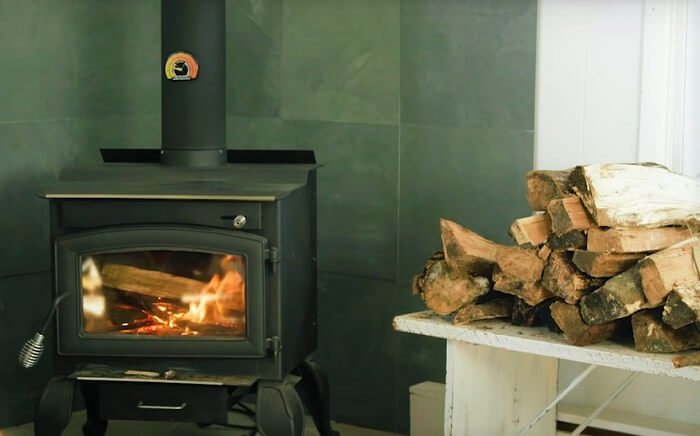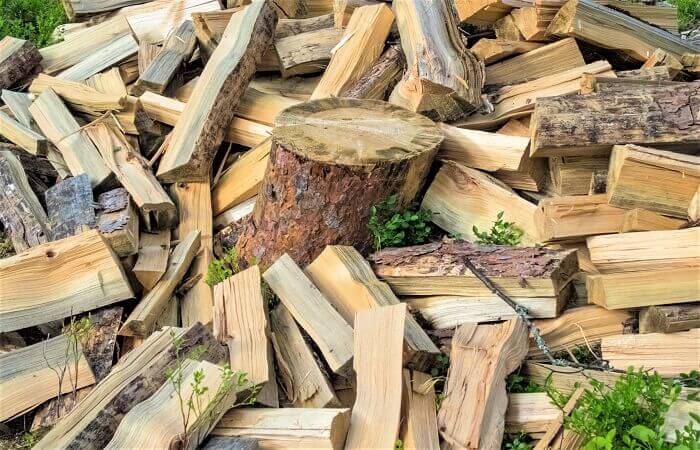Why Does My Fireplace Burn Wood So Fast? How to Make it Slower?
Note: This article may contain affiliate links, which means if you make a purchase following our links won’t cost you extra, but we may earn a commission. Learn more
If you’ve ever wondered why your fireplace or stove burns wood so quickly, you’re not alone. Many people have the same question, and there are a few different reasons why this happens. One reason is that fireplaces are designed to draw air from the room in order to keep the fire going.
This can cause the wood to burn faster than it would if it were just sitting in the room. Another reason is that dry wood burns hotter and faster than wet wood. So, if your wood is particularly dry, it will burn quickly.
Lastly, the size of the logs can also affect how fast they burn. If you’re using small logs, they’ll obviously burn up quicker than large ones.

How Do You Stop Wood Burning So Fast?
There are a few things you can do to stop your wood from burning so quickly. One is to make sure that you’re using the right kind of wood. Hardwoods like oak or maple will burn slower than softer woods like pine.
Another thing you can do is to season your wood properly. This means letting it dry out for at least six months before using it in a fire. You can also use a moisture meter to make sure that your wood is sufficiently dry.
Finally, you can use a slow-burning log starter or an electric fireplace inserts to help get your fire going and then add larger pieces of wood once the flames are established.
How Long Should a Log Last on a Wood Burner?
Assuming you’re talking about a wood-burning stove: A well-maintained wood stove should last anywhere from 10 to 20 years. Of course, this varies depending on the model of the stove, how often it is used, and how well it is taken care of.
To get the most out of your wood stove, it is important to give it regular maintenance. This means sweeping the chimney at least once a year, checking for cracks or damage in the firebox and flue, and making sure all the parts are in good working order.
By taking these simple steps, you can help extend the life of your wood stove and ensure that it continues to operate safely and efficiently for many years to come.

How to Make Your Wood Burn Slower in a Fireplace or a Stove?
Slow-burning wood is key to a warm, efficient fire. Here are a few tips on how to make your wood burn slower in a fireplace or stove:
1. Start with dry, well-seasoned wood. Wet wood will not only produce less heat but will also create more smoke and creosote buildup.
2. Build a small, hot fire. A big, blazing fire may look nice, but it will actually burn through wood much faster.
3. Use a grate. A fireplace grate will help circulate air around the fire, making it burn hotter and slower.
4. Add some firewood logs. This may seem counterintuitive, but adding a few extra logs to your fire will actually make it burn slower. The extra wood will help to insulate the fire, making it last longer.
5. Close the damper. The damper is the metal plate that covers the opening to your fireplace. When it’s open, it allows oxygen to flow into the fire, making it burn hotter and faster. Closing the damper will help to slow the fire down.
What Wood Burns the Slowest in a Fireplace?
While there are many factors that affect how long a piece of wood will burn in a fireplace, the general rule of thumb is that denser wood will burn slower than less dense wood. This is because denser woods have more mass and therefore take longer to heat up and ignite. Some of the slowest burning woods include oak, hickory, and maple.
These hardwoods are ideal for use in fireplaces as they provide a long-lasting, steady flame. Softer woods such as pine and cedar may burn faster, but they also tend to produce more sparks and pop more, which can be a nuisance. Another factor to consider when choosing wood for your fireplace is the moisture content.
Woods with a higher moisture content will burn less efficiently than dryer woods. If you live in an area with high humidity, it’s best to let your wood sit for several weeks or even months before burning it to allow the moisture to evaporate.

How Long Does Wood Burn in a Fireplace?
Assuming you’re talking about a wood-burning fireplace:How long does wood burn in a fireplace? It really depends on the size of the fire, the type of wood, and how dry it is.
A small, hot fire made with dry hardwood will last longer than a big, slow-burning fire made with softwood. In general, though, you can expect a fire to burn for anywhere from 30 minutes to several hours.
Wood Stove That Burns for 12 Hours
If you’re in the market for a wood stove that will keep your home toasty warm for 12 hours at a time, there are a few things you should know. For starters, 12-hour wood stoves typically come in two different varieties: pellet-burning and cordwood-burning. Both have their pros and cons, so it’s important to do your research before making a purchase.
Pellet-burning wood stoves are more expensive up front, but they’re also much more efficient than cordwood-burning stoves. They burn pellets made from compressed sawdust, which means there’s very little smoke or ash produced. Pellet-burning stoves also tend to be easier to operate since you simply load them with pellets and push a button to start the fire.
The downside is that you’ll need to buy pellets on a regular basis, which can add up over time. Cordwood-burning wood stoves are less expensive than pellet-burning stoves, but they require more work to operate. You’ll need to chop and split your own firewood before loading it into the stove, and then carefully monitor the fire throughout the day to make sure it doesn’t go out.
Cordwood-burning stoves also produce more smoke and ash than pellet-burning stoves, so they require more frequent cleaning. No matter which type of 12-hour wood stove you choose, one thing is for sure: you won’t be left out in the cold!
Can You Leave a Wood Stove Burning Overnight?
If you’re considering leaving a wood stove burning overnight, there are a few things to keep in mind. First, it’s important to have a well-insulated home – this will help to prevent any heat loss and keep your home comfortable while the stove is going. Second, you’ll want to make sure that the flue is clear and unobstructed so that smoke and fumes can vent properly.
Also, it’s always a good idea to have a fire extinguisher on hand in case of an emergency. With these safety precautions in mind, you can enjoy the warmth of your wood stove all night long!
Conclusion
Although a fireplace or a stove is a cozy addition to any home, burning wood in it can be a challenge. If you find that your fireplace is burning wood too fast, there are a few things you can do to make it burn slower. One way is to add a layer of ashes to the bottom of the fireplace. This will help to insulate the fire and make it burn slower.
Another way to make your fireplace burn wood slower is to add some sand to the bottom of the fire. This will help to absorb the heat and make the fire burn slower. Finally, you can also add some green wood to the fire. This will help to create more smoke, which will help to slow down the fire.
